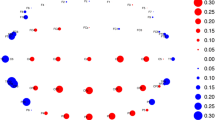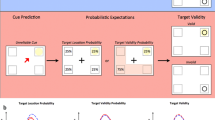Abstract
The benzodiazepines slow information processing and the sites of this slowing were mapped using the Additive Factors Method in combination with the P300 component of the event-related brain potential. It was assumed that P300 largely reflects the time to evaluate a stimulus while reaction time (RT) reflects this time plus the time to select and execute a response. Twelve subjects were administered 0.25 mg triazolam in a repeated measures single-blind design. A visual 80–20% oddball task was used in which stimulus intensity and signal quality were manipulated with accuracy of responding held constant at a high level. RT and EEG data were collected simultaneously and the P300 elicited by the low probability stimuli was measured on a single trial basis. Triazolam slowed RT (172 ms,P<0.0003) more than P300 (88 ms,P<0.0007), but both measures exhibited a drug × stimulus intensity interaction. RT also exhibited a drug × signal quality interaction but P300 did not. These results suggest that triazolam has selective effects on perceptual processing by slowing an early preprocessing stage but not a later feature extraction stage. In addition, the drug appears to slow some aspect of response processing. This evidence is taken as support for a multiple process rather than a general sedation view of benzodiazepine effects on stages of processing.
Similar content being viewed by others
References
Bashore TR (1990) Age-related changes in mental processing revealed by analyses of event-related brain potentials. In: Rohrbaugh JW, Parasuraman R, Johnson Jr R (eds) Event-related brain potentials: basic issues and applications. Oxford, New York, pp 242–275
Bootsma RJ, Van Wieringen PCW (1990) Timing an attacking forehand drive in table tennis. J Exp Psychol Hum Percept Perf 16: 21–29
Curran HV (1986) Tranquillising memories: a review of the effects of benzodiazepines on human memory. Biol Psychol 23: 179–213
Donchin E, Karis D, Bashore TR, Coles MGH, Gratton G (1986) Cognitive psychophysiology and human information processing. In: Coles MGH, Donchin E, Porges SW (eds) Psychophysiology: systems, processes and applications. Elsevier, Amsterdam, pp 244–267
Dorian P, Sellers EM, Kaplan HL, Hamilton HL, Greenblatt DJ, Abernathy D (1985) Triazolam and ethanol interaction: kinetic and dynamic consequences. Clin Pharmacol Ther 37: 558–562
Erwin CW, Linnoila M, Harwell J, Erwin A, Guthrie S (1986) Effects of buspirone and diazepam, alone and in combination with alcohol, on skilled performance and evoked potentials. J Clin Psychopharmacol 6:199–209
Fabiani M, Gratton G, Karis D, Donchin E (1987) Definition, identification, and reliability of measurement of the P300 component of the event-related brain potential. In: Ackles PK, Jennings JR, Coles MGH (eds) Advances in psychophysiology, vol 2. JAI Press, Greenwich CT, pp 1–78
Ford JM, Mohs RC, Pfefferbaum A, Kopell BS (1980) On the utility of P3 latency and RT for studying cognitive processes. In: Kornhuber HH, Deecke L (eds) Motivation, motor and sensory processes of the brain: electrical potentials, behaviour and clinical use. Elsevier, Amsterdam, pp 661–667
Fowler B, Adams J (1993) Dissociation of the effects of alcohol and amphetamine on inert gas narcosis using reaction time and P300 latency. Aviat Space Environ Med 64: 493–499
Fowler B, Hamilton K, Porlier G (1987) Interactions between ethanol, amphetamine and inert gas narcosis on the performance of a memory scanning task. In: Bachrach AJ, Bove AA, Greenbaum LG (eds) Underwater physiology IX: Proceedings of the ninth symposium on underwater and hyperbaric physiology. Undersea and Hyperbaric Medical Society, Bethesda, pp 583–588
Fowler B, Banner J, Pogue J (1993a) The slowing of visual processing by hypoxia. Ergon 36: 727–735
Fowler B, Hamel R, Lindeis A-E (1993b) Relationship between the event-related brain potential P300 and inert gas narcosis. Undersea Hyperbaric Med 20: 49–62
Gratton G, Coles MGH, Donchin E (1983) A new method for offline removal of ocular artifact. Electroencephalogr Clin Neurophysiol 55: 468–484
Johnson LC, Chernik DA (1982) Sedative-hypnotics and human performance. Psychopharmacology 76: 101–113
Julesz B (1971) Foundations of cyclopean perception. University of Chicago, Chicago
Koelega HS (1989) Benzodiazepines and vigilance performance: a review. Psychopharmacology 98: 145–156
Krogh CME (ed) (1993) Compendium of pharmaceuticals and specialities (27th edn). Canadian Pharmaceutical Association, Ottawa, Canada
McCarthy G, Donchin E (1983) Chronometric analysis of human information processing. In: Gaillard AWK, Ritter W (eds) Tutorials in event-related potentials research: endogenous components. North-Holland, Amsterdam, pp 251–268
McGlone FP, Kulikowski JJ, Kranda K, Ott H (1988) Post-ingestion effects of benzodiazepines on evoked potentials and reaction times in discrimination tasks. In: Hindmarch I, Aufdembrinke B, Ott H (eds) Psychopharmacology and reaction time. John Wiley, New York, pp 145–154
Milligan KR, Lumsden J, Howard RC, Howe JP, Dundee JW (1989) Use of auditory evoked responses as a measure of recovery from benzodiazepine sedation. J R Soc Med 82: 595–597
O'Hanlon JF, de Gier JJ (eds) (1986) Drugs and driving. Taylor & Francis, London
Pfefferbaum A, Christensen C, Ford JM, Kopell BS (1986) Apparent response incompatibility effects on P3 latency depend on the task. Electroencephalogr Clin Neurophysiol 64: 424–437
Regan D (1989) Human brain electrophysiology: evoked potentials and evoked magnetic fields in science and medicine. Elsevier, New York
Rich JB, Brown GG (1992) Selective dissociations of sedation and amnesia following ingestion of diazepam. Psychopharmacology 106: 346–350
Rockstroh B, Elbert T, Lutzenberger W, Altenmuller E (1991) Effects of the anticonvulsant benzodiazepine clonazepam on event-related brain potentials in humans. Electroencephalogr Clin Neurophysiol 78: 142–149
Rösler F, Sutton S, Johnson Jr R, Mulder G, Fabiani M, Plooij-Van Gorsel E, Roth WT (1986) Endogenous ERP components and cognitive constructs. A review. In: McCallum WC, Zappoli R, Denoth F (eds) Cerebral psychophysiology: studies in event-related potentials (EEG Suppl. 38). Elsevier, Amsterdam, pp. 51–92
Sanders AF (1980) Stage analysis of reaction processes. In: Stelmach GE, Requin J (eds) Tutorials in motor behavior. North-Holland, Amsterdam, pp 331–354
Sanders AF (1983) Towards a model of stress and human performance. Acta Psychol 53: 61–97
Spinweber CL, Johnson LC (1982) Effects of triazolam (0.5 mg) on sleep, performance, memory, and arousal threshold. Psychopharmacology 76: 5–12
Sternberg S (1969) The discovery of processing stages: extensions of Donders' method. Acta Psychol 30: 276–315
Subhan Z (1984) The effects of benzodiazepines on short-term memory and information processing. In: Hindmarch I, Ott H, Roth T (eds) Sleep, benzodiazepines and performance: experimental methodology and research prospects. Springer, Berlin, pp 173–181
Subhan Z, Hindmarch I (1984) Effects of zopiclone and benzodiazepine hypnotics on search in short-term memory. Neuropsychobiology 12: 244–248
Van der Molen MW, Bashore TR, Halliday R, Callaway E (1991) Chronopsychophysiology: mental chronometry augmented by psychophysiological time markers. In: Jennings JR, Coles MGH (eds) Handbook of cognitive psychophysiology: central and autonomic nervous system approaches. John Wiley, Chichester, pp 9–178
Walton P, Callaway E, Halliday R, Naylor H (1987) Stimulus intensity, contrast, and complexity have additive effects on P300 latency. In: Johnson Jr R, Rohrbaugh JW, Parasuraman R (eds) Current trends in event-related potential research (EEG Suppl 40). Elsevier, New York, pp 284–292
Weingartner HJ, Hommer D, Lister RG, Thompson K, Wolkowitz O (1992) Selective effects of triazolam on memory. Psychopharmacology 106: 341–345
Wickens CD (1984) Engineering psychology and human performance. Charles Merrill, Columbus, pp 357–376
Williams HL, Rundell Jr OH, Smith LT (1981) Dose effects of secobarbital in a Sternberg memory scanning task. Psychopharmacology 72: 161–165
Wittenborn JR (1979) Effects of benzodiazepines on psychomotor performance. Br J Clin Pharmacol 7: 61S-67S
Author information
Authors and Affiliations
Rights and permissions
About this article
Cite this article
Pang, E., Fowler, B. Discriminating the effects of triazolam on stimulus and response processing by means of reaction time and P300 latency. Psychopharmacology 115, 509–515 (1994). https://doi.org/10.1007/BF02245575
Received:
Revised:
Issue Date:
DOI: https://doi.org/10.1007/BF02245575




